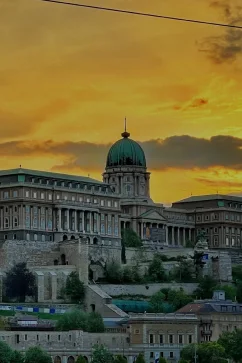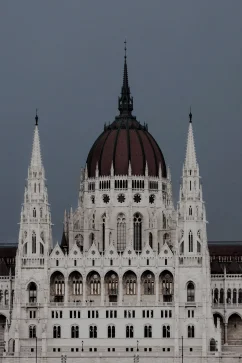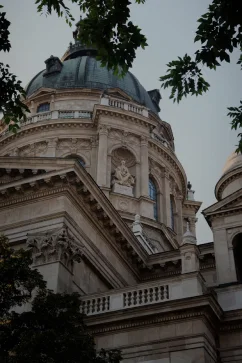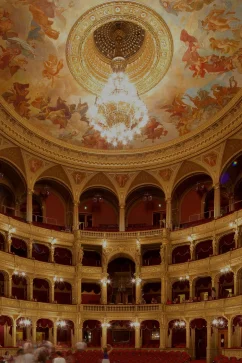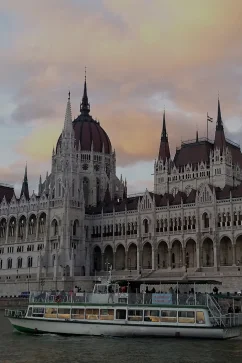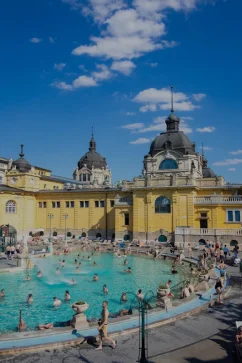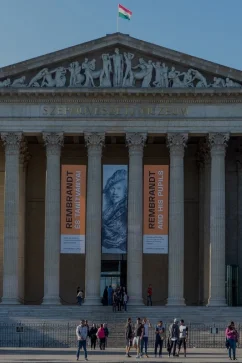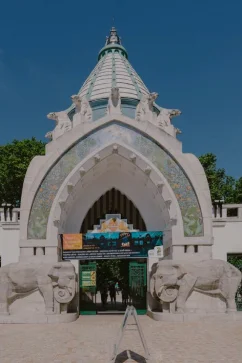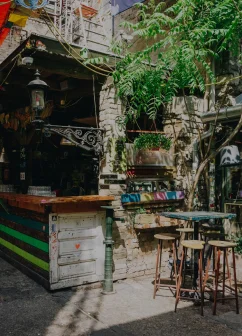Fisherman’s Bastion

About Fisherman’s Bastion
Fisherman’s Bastion consists of fairytale-like towers; each tower offers an incredible view of the city. The Danube River winds through the scene, reflecting the city lights like a shimmering ribbon – increasing the fun of Bastion’s visit. Its vast structure, romantic balcony, and giant courtyard present a scene of breathtaking cityscape. Fisherman’s Bastion’s stairs are unique and visually attractive; climbing on them gives a complete Fisherman’s Bastion view. The Fisherman’s Bastion at night turns into a sparkling wonderland. As you explore the Bastion at night, don’t miss the statue of St. Stephen, Hungary’s first king, proudly watching over his city.
Right next to the Fisherman’s Bastion is Fisherman Bastion Church – Matthias Church. It looks stunning outside at night, but inside Matthias church, you can discover historical treasures, from colorful mosaics to Gothic architecture. Halászbástya is a terrace in the Buda Castle, surrounded by Fisherman’s Bastion. This eye-catching terrace offers panoramic Budapest views – the Danube River, the Hungarian Parliament Building, and Margaret Island. Fisherman’s Bastion has more than grand views; it is a secret world of towers and turrets with unique tiles. These aren’t your average tiles; they’re hand-painted masterpieces showing astonishing Hungarian legends, historical figures, and mythical creatures
History of the Fisherman’s Bastion
Fisherman’s Bastion history is fully enriched as it has witnessed many wars, transformations, and ever-changing views. Fisherman’s Bastion, in the Hungarian state, isn’t just a landmark but a journey through history and breathtaking views. The name shows that Fisherman built Bastion, but it is not valid. The Bastion was constructed by Hungarian architect Frigyes Schulek in 1902 on King Hungary’s 1000th birthday. The Bastion boasts seven towers, each symbolizing a Hungarian tribe and a statue of St Stephen – Hungary’s first king. When you wander through its charming turrets, each offering panoramic city vistas and the Danube River sparkling below.
The seven towers of Halaszbastya represent the seven Hungarian chieftains who guided their tribes to settle in present-day Hungary in 895. Additionally, the statue of St. Stephen (1906), the first Hungarian king (1000-1038), graces the site. In essence, it stands as a historical monument commemorating millennial Hungary. Originally intended as a viewing terrace, the Bastion offers a fairytale-like experience, transporting you back in time rather than showcasing heavy fortifications. The Bastion was damaged during World War II but is now fully restored, showcasing the dedication to preserving its unique charm. In the 1970s, things changed politically. People argued about building the Hilton Hotel, debating between modern progress and keeping the historic charm. After communism ended, they took down the Red Star, showing a fresh start. They worked hard to restore it, not just the structure but its history. Now, it stands for Budapest’s history and strong spirit.

Tips for your visit to the Fisherman’s Bastion
- Fisherman’s Bastion opening hours are Monday – Sunday, 12 am–midnight; you can visit it anytime. Yet, visiting Bastion early in the morning is recommended to avoid crowds and enjoy better photo opportunities.
- Arriving before provides a peaceful setting and stunning views without the mid-day rush.
- Experience Fisherman’s Bastion after dark for a unique ambiance with city lights.
- Take advantage of free entry in the early morning, evenings, specific holidays, and late December to early January.
- Wear comfortable shoes for walking and climbing stairs during exploration.
Tickets for the Fisherman’s Bastion
According to the Buda Castle municipality, the adult tickets for Fisherman’s Bastion are HUF 1200 (about 3.4 Euros). However, there are discount tickets for students & children under 14; the price for these tickets is HUF 600 (approximately 1.7 Euro). The entry ticket for pensioners (from EU member states) is HUF 600. Guides leading a group of 5 or more individuals are eligible for free entry, and similarly, kids under 6 are also free.
Fortunately, there are many more occasions and timings when entries are free in Fisherman Bastion, such as mornings before 9:00 am, evenings after 9 pm (between June 1 and September 30), and evenings after 7 pm (between October 1 and May 31). In addition, March 15 (national holiday), August 20 (national holiday), and October 23 (national holiday) are dates when visitors can enter Fisherman’s Bastion without any cost.
How to arrive to the Fisherman’s Bastion
Reaching Fisherman’s Bastion offers several convenient options. Typically, Metro M2 to Batthyány ter is the most convenient option. Metro M2 is accessible from Astoria, Deak Ferenc Ter, or Kossuth Lajos Tér stations. Moreover, you can take either Bus 16 or Bus 16A and get down at the Fisherman’s Bastion stop on the “Szentháromság tér” terminal which is by far the closest stop to the Fisherman’s Bastion. And then, you go uphill for a short distance to get to the bastion.
If you prefer less walking, you can select the Castle Hill Funicular (Sikló) from The Adam Clark Square (Clark Ádám tér) located at the Buda side of Chain Bridge. The funicular brings you straight to the Castle District and from there you can walk to Fisherman’s Bastion. Besides, if you’re staying within a district that is near the Castle District or exploring the Castle District, you can travel to Fisherman’s Bastion by foot. It’s a beautiful walk through the touristy streets and old pathways, a path paved with stones.

